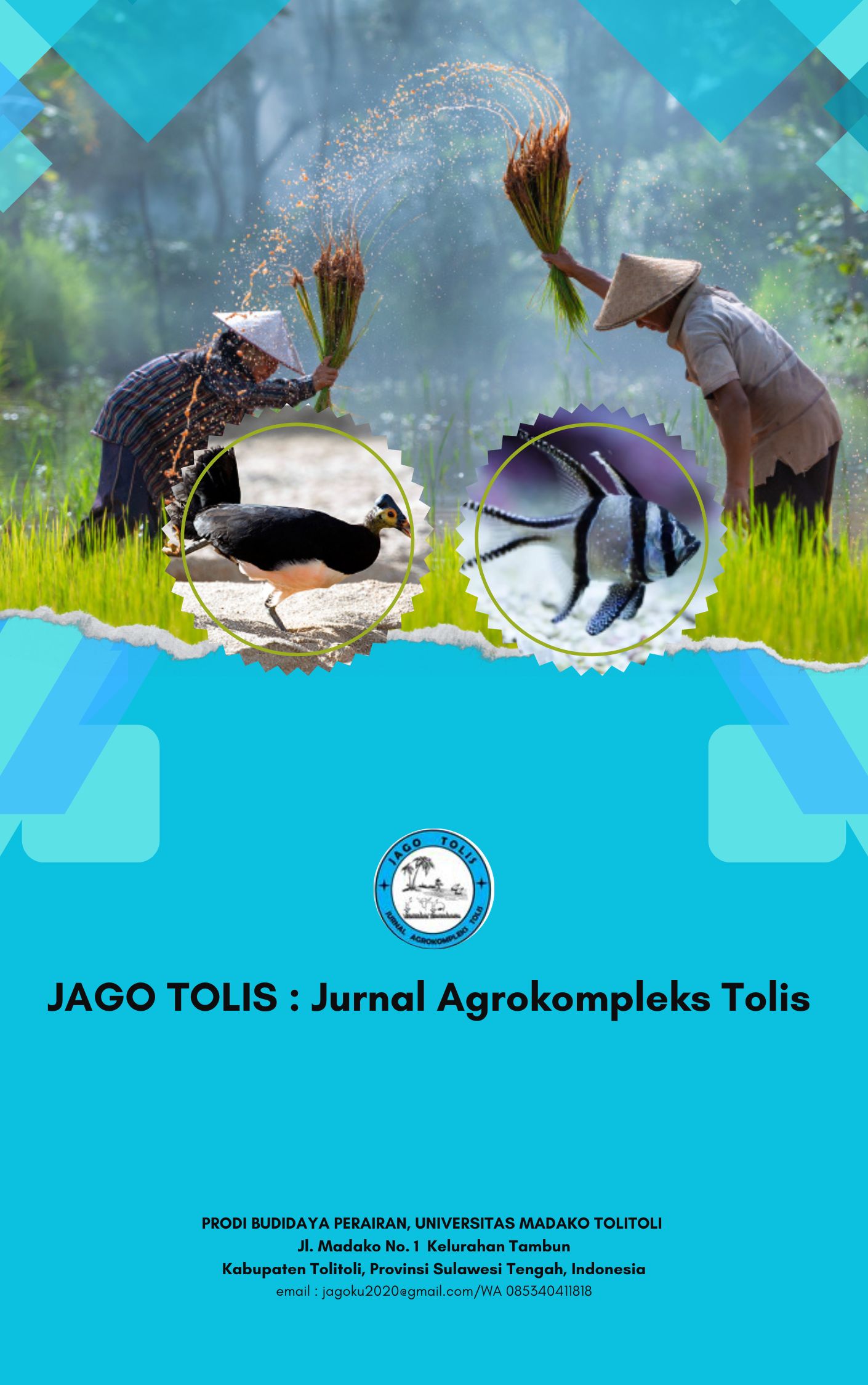Study of Chicory Utilization as Animal Feed: Analysis of Potential and Implementation Challenges in the Tropics
DOI:
https://doi.org/10.56630/jago.v6i1.1058Keywords:
Animal Feed; Animal Nutrition And Health; Cichorium Intybus; Sustainable Agriculture.Abstract
Cichorium intybus L. (chicory) is a perennial forage with considerable potential to support sustainable livestock systems, particularly in tropical regions. This study aims to evaluate its nutritional composition, agronomic performance, and livestock response. A literature-based review supported by field trial data was employed, focusing on nutrient analysis, cultivation practices, animal feeding performance, and economic viability. Quantitative findings indicate that chicory contains 14–22% crude protein and 10–20% inulin (dry weight basis), with forage yields reaching 8–12 t DM/ha/year under optimal management. Feeding trials demonstrate improvements in milk yield by 5–12%, reductions in nitrogen excretion by 10–15%, and decreases in gastrointestinal parasite load by 30–40% compared with conventional grass-based diets. Agronomically, chicory thrives in well-drained soils with balanced fertilization and responds positively to high-frequency irrigation and integrated pest management, although breeding for tropical adaptation remains essential. Despite its high nutritive value and bioactive properties, economic challenges such as high input costs and limited market access constrain broader adoption. Overall, chicory represents a promising alternative forage crop that enhances animal productivity, health, and environmental efficiency, while contributing to climate-resilient livestock production systems in tropical settings.
References
Al-Snafi, A. E. (2016). Medical importance of Cichorium intybus–A review. IOSR Journal of Pharmacy, 6(3), 41–56.
Aldahak, L., Salem, K. F. M., Al-Salim, S. H. F., & Al-Khayri, J. M. (2021). Advances in chicory (Cichorium intybus L.) breeding strategies. Advances in Plant Breeding Strategies: Vegetable Crops: Volume 10: Leaves, Flowerheads, Green Pods, Mushrooms and Truffles, 3–57.
Atzori, G., Nissim, W. G., Caparrotta, S., Santantoni, F., & Masi, E. (2019). Seawater and water footprint in different cropping systems: A chicory (Cichorium intybus L.) case study. Agricultural Water Management, 211, 172–177.
Bhatt, M. K., Labanya, R., & Joshi, H. C. (2019). Influence of long-term chemical fertilizers and organic manures on soil fertility-A review. Universal Journal of Agricultural Research, 7(5), 177–188.
Birsa, M. L., & Sarbu, L. G. (2023). Health Benefits of Key Constituents in Cichorium intybus L. Nutrients, 15(6), 1322.
Bortolini, L., & Tolomio, M. (2019). Low-and high-frequency irrigation of Rosso di Treviso Radicchio. IX International Symposium on Irrigation of Horticultural Crops 1335, 687–692.
Gabryś, B., & Kordan, B. (2022). Cultural control and other non-chemical methods. In Insect Pests of Potato (pp. 297–314). Elsevier.
Garrett, K., Beck, M. R., Marshall, C. J., Maxwell, T. M. R., Logan, C. M., Greer, A. W., & Gregorini, P. (2022). It is not just what is fed but how we serve it through time—a varied pasture-based diet increases intake of lambs. Livestock Science, 261, 104954.
Irshad, R., Yousuf, M., & Ikram, M. (2025). Role of Trichogramma in biological control of pests in India: A concise review. Journal of Biological Control, 39(1), 1–13.
Jan, G., Kahan, M., Ahmad, M., Iqbal, Z., Afzal, A., Afzal, M., Shah, G. M., Majid, A., Fiaz, M., & Zafar, M. (2011). Nutritional analysis, micronutrients and chlorophyll. Journal of Medicinal Plants Research, 5(12), 2452–2456.
Janda, K., Gutowska, I., Geszke-Moritz, M., & Jakubczyk, K. (2021). The common cichory (Cichorium intybus L.) as a source of extracts with health-promoting properties—a review. Molecules, 26(6), 1814.
Jinjing, C., Lihong, G., & Zhifu, C. (2005). Present situation of the effect of fertilization measures on protected soil and crop. Transactions of the Chinese Society of Agricultural Engineering (Transactions of the CSAE), 21, 16–20.
Khan, A., Khan, A. A., Samreen, S., & Irfan, M. (2023). Assessment of Sodium Chloride (NaCl) Induced Salinity on the Growth and Yield Parameters of Cichorium intybus L. Nature Environment & Pollution Technology, 22(2).
Khan, A. M. A., & Chandra, K. (2024). Medicinal and Nutritional Importance of Cichorium intybus in Human Health. In Medicinal Plants and their Bioactive Compounds in Human Health: Volume 1 (pp. 251–271). Springer.
Li, G., & Kemp, P. D. (2005). Forage chicory (Cichorium intybus L.): a review of its agronomy and animal production. Advances in Agronomy, 88, 187–222.
Mangwe, M., Bryant, R., & Gregorini, P. (2020). Rumen fermentation and fatty acid composition of milk of mid lactating dairy cows grazing chicory and ryegrass. Animals, 10(1), 169.
Mangwe, M. C., Bryant, R. H., Olszewski, A., Herath, H. M. G. P., & Al-Marashdeh, O. (2024). Can the Inclusion of Forage Chicory in the Diet of Lactating Dairy Cattle Alter Milk Production and Milk Fatty Acid Composition? Findings of a Multilevel Meta-Analysis. Animals, 14(7), 1002.
Marley, C. L., Fychan, R., Davies, J. W., Scollan, N. D., Richardson, R. I., Theobald, V. J., Genever, E., Forbes, A. B., & Sanderson, R. (2014). Effects of chicory/perennial ryegrass swards compared with perennial ryegrass swards on the performance and carcass quality of grazing beef steers. PloS One, 9(1), e86259.
Mathieu, A.-S., Tinel, C., Dailly, H., Quinet, M., & Lutts, S. (2018). Impact of high temperature on sucrose translocation, sugar content and inulin yield in Cichorium intybus L. var. sativum. Plant and Soil, 432, 273–288.
Minneé, E. M. K., Waghorn, G. C., Lee, J. M., & Clark, C. E. F. (2017). Including chicory or plantain in a perennial ryegrass/white clover-based diet of dairy cattle in late lactation: Feed intake, milk production and rumen digestion. Animal Feed Science and Technology, 227, 52–61.
Mohammadi, H., Abdollahi-Bastam, S., Aghaee, A., & Ghorbanpour, M. (2024). Foliar-applied silicate potassium modulates growth, phytochemical, and physiological traits in Cichorium intybus L. under salinity stress. BMC Plant Biology, 24(1), 288.
Papafilippaki, A., & Nikolaidis, N. P. (2020). Comparative study of wild and cultivated populations of Cichorium spinosum: The influence of soil and organic matter addition. Scientia Horticulturae, 261, 108942.
Patkowska, E., & Konopinski, M. (2008). Pathogenicity of selected soil-borne fungi for seedlings of root chicory (Cichorium intybus L. var. sativum Bisch.). Vegetable Crops Research Bulletin, 69, 81.
Peña-Espinoza, M., Valente, A. H., Thamsborg, S. M., Simonsen, H. T., Boas, U., Enemark, H. L., López-Muñoz, R., & Williams, A. R. (2018). Antiparasitic activity of chicory (Cichorium intybus) and its natural bioactive compounds in livestock: a review. Parasites & Vectors, 11, 1–14.
Peres, A. A. de C., Portz, A., Machado, P. de F., Peixoto, S. de P., & Ribeiro, J. de S. (2021). Production of costs analysis of alface americana, almeirão, mostarda and rúcula in a farm from Volta Redonda city in Rio de Janeiro state.
Perović, J., Šaponjac, V. T., Kojić, J., Krulj, J., Moreno, D. A., García-Viguera, C., Bodroža-Solarov, M., & Ilić, N. (2021). Chicory (Cichorium intybus L.) as a food ingredient–Nutritional composition, bioactivity, safety, and health claims: A review. Food Chemistry, 336, 127676.
Pittman, J. J., Interrante, S. M., & Butler, T. J. (2015). Response of Forage Chicory to Various Herbicides. Crop, Forage & Turfgrass Management, 1(1), 1–6.
Poursakhi, N., Razmjoo, J., & Karimmojeni, H. (2020). Nutritional qualities, chemical compositions, and yield of chicory genotypes. Agronomy Journal, 112(1), 344–351.
Rahman, H., Khan, U. A., Qasim, M., Muhammad, N., Khan, M. D., Asif, M., Azizullah, A., Adnan, M., & Murad, W. (2016). Ethnomedicinal Cichorium intybus seed extracts: An impending preparation against multidrug resistant bacterial pathogens. Jundishapur Journal of Microbiology, 9(11), e35436.
Ramarethinam, S., Marimuthu, S., & Murugesan, N. V. (2005). Entomopathogenic fungi, Verticillium lecanii–An overview. Pestology, 24(12), 9–30.
Rattanasomboon, T., Wester, T. J., Smith, S. L., & Morel, P. C. H. (2019). Nutritive value of plantain and chicory for pigs. Livestock Science, 223, 8–15.
Saeed, M., El-Hack, M. E. A., Alagawany, M., Arain, M. A., Muhammad Arif, M. A., Mirza, M. A., Naveed, M., Chao Sun, C. S., Muhammad Sarwar, M. S., & Maryam Sayab, M. S. (2017). Chicory (Cichorium intybus) herb: chemical composition, pharmacology, nutritional and healthical applications.
Saeed, M., Siddique, F., Sultan, R., El Sayed, S. A. A., Ahmed, S. Y. A., Farag, M. R., Abd El-Hack, M. E., Shehata, A. M., & Alagawany, M. (2022). Use of Chicory (Cichorium intybus) and its Derivatives in Poultry Nutrition. In Antibiotic Alternatives in Poultry and Fish Feed (pp. 98–110). Bentham Science Publishers.
Shad, M. A., Nawaz, H., Rehman, T., & Ikram, N. (2013). Determination of some biochemicals, phytochemicals and antioxidant properties of different parts of Cichorium intybus L.: A comparative study. J Anim Plant Sci, 23(4), 1060–1066.
Singh, M., Kumar, S., Banakar, P. S., Vinay, V. V, Das, A., Tyagi, N., & Tyagi, A. K. (2021). Synbiotic formulation of Cichorium intybus root powder with Lactobacillus acidophilus NCDC15 and Lactobacillus reuteri BFE7 improves growth performance in Murrah buffalo calves via altering selective gut health indices. Tropical Animal Health and Production, 53(2), 291.
Sithanantham, S. (2023). Organic Pest Management: Emerging Trends and Future Thrusts. Organic Crop Production Management, 267–277.
Sofyan, E. T., & Sara, D. S. (2019). The effect of organic and inorganic fertilizer applications on N, P and K uptake and yield of sweet corn (Zea mays saccharata Sturt). Journal of Tropical Soils, 23(3), 111–116.
Tamburini, E., Pedrini, P., Marchetti, M. G., Fano, E. A., & Castaldelli, G. (2015). Life cyclebased evaluation of environmental and economic impacts of agricultural productions in the Mediterranean area. Sustainability, 7(3), 2915–2935.
Tasca, A. L., Nessi, S., & Rigamonti, L. (2017). Environmental sustainability of agri-food supply chains: An LCA comparison between two alternative forms of production and distribution of endive in northern Italy. Journal of Cleaner Production, 140, 725–741.
Tilova, A. M., Umami, N., Suhartanto, B., Astuti, A., & Suseno, N. (2021). Effects of different level of nitrogen fertilizer on growth and production of Cichorium intybus at the eighth regrowth. IOP Conference Series: Earth and Environmental Science, 788(1), 12163.
Umami, N., Abdiyansah, A., & Agus, A. (2019). Effects of different doses of NPK fertilization on growth and productivity of Cichorium intybus. IOP Conference Series: Earth and Environmental Science, 387(1), 12097.
Umami, N., Dewi, M. P., Suhartanto, B., Suseno, N., & Agus, A. (2020). Effect of planting densities and fertilization levels on the production and quality of Chicory (Cichorium intybus) in Yogyakarta, Indonesia. IOP Conference Series: Earth and Environmental Science, 425(1), 12073.
Umami, N., Rahayu, E. R. V, Suhartanto, B., Agus, A., & Rahman, M. M. (2022). Selenium application in improving chicory (Cichorium intybus) productivity and quality. Tropical Animal Science Journal, 45(3), 337–347.
Wang, L., Fan, J., Wei, C., Li, G.-Z., Zhang, J.-J., Jiao, Q.-J., Chen, G., Sun, L.-Z., & Liu, H.-T. (2021). Mitigative effect of exogenous ascorbic acid on the growth of copper-stressed chicory (Cichorium intybus) seedlings.
Woodmartin, S., Creighton, P., Boland, T. M., Farrell, L., Claffey, N., & McGovern, F. (2024). The inclusion of companion forages in the diet alongside perennial ryegrass increased dry matter intake and organic matter digestibility in sheep. Animal, 18(5), 101150.
Zhang, H., Yang, S., Wei, X., Wang, L., Sun, X., Hou, Z., Zhong, Q., & Liu, W. (2023). Forecasting the favorable growth conditions and suitable regions for chicory (Cichorium intybus L.) on the Qinghai plateau under current climatic conditions. Ecological Informatics, 78, 102343.
















